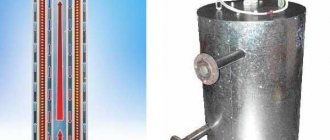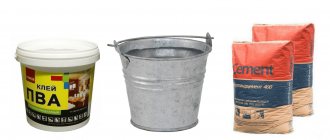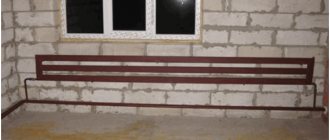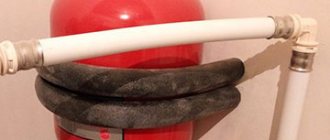A heating register is an integral part of the heating system, a device consisting of several parallel horizontal smooth pipes. This type of heating device has not gained much popularity among private homeowners, and there are objective reasons for this. A register-based heating system has a large volume of coolant, which requires much more energy to heat than with conventional radiators.
A mobile heating register with a built-in heating element allows you to move the device to another location in a short time in case of an emergency.
Application area
Currently, water heating registers are mostly used in industries (workshops, workshops, warehouses, hangars and other buildings with large areas). The large volume of coolant and large dimensions allow the registers to efficiently heat such rooms.
The use of heating registers in industrial buildings ensures the most optimal efficiency of the heating system. Compared to cast iron or steel batteries, registers are characterized by better hydraulics and heat dissipation. The relatively low cost of their manufacture reduces the cost of installing the entire factory heating system. In addition, they are not expensive to operate.
Registers are also recommended for use in premises with high sanitary safety requirements (medical institutions, kindergartens, etc.). The devices are easily washed from dirt and dust.
Despite this, the concept of efficiency does not apply to this type of heating device. As noted above, heating a large volume of coolant requires a lot of energy.
Heating registers at one of the food industry production facilities in the Moscow region.
Heating registers made of steel electric-welded pipes can be used in both single-pipe and two-pipe heating systems with forced or gravity circulation of the coolant (based on water or steam).
Note! Due to the large volume of coolant, which requires a lot of fuel to heat, only enterprises can afford to use heating registers, but not the owners of private houses, for whom the efficiency of the heating system is important.
Convector and oil heater comparison reveals the undoubted leader
So, let's compare the main indicators of the two most popular heaters.
1. Economical use. An oil radiator consumes a quarter more electricity than a convector radiator. Since electricity tariffs are constantly rising, this fact may be decisive when choosing a device.
2. Warm-up time. Heating the air with an oil heater goes through several stages: first, electricity heats the heating element, then the heating element heats the oil, and it, in turn, heats the fins of the housing, which gives off heat to the air masses. This takes a lot of time (and costs a lot of electricity) - the device has been turned on for a long time, and the cold is still in the room. Fans built into the oil heater can speed up the process.
In a convector, the heating element immediately heats the body, so its efficiency is at least 95 percent. But the heating rate is also not so high and an oil radiator equipped with a fan, all other things being equal, is more likely to outperform a convector.
3. Comfort during work. This refers to ease of carrying and installation. It should be noted that convectors are more convenient and mobile in this regard. Their weight is no more than 10 kilograms, and oil devices are more bulky and heavy - their weight ranges from 18 to 25 kilograms. Convectors on wheels are more convenient to move, and they are easy to mount on the wall, which will save space in the apartment and make cleaning easier. In addition, the temperature created by the convector is more comfortable. It has no differences throughout the entire volume of the room.
4. Security. You understand that hot oil is not the best neighbor. It heats up the heater body so much that it’s not far from a burn. The exception is heaters equipped with a protective casing.
But convector devices can be called absolutely safe. After all, their body heats up to only 60 degrees, and at this temperature you cannot get burned. Equipped with a protection function, a convector left unattended will not cause any harm to the owner. But under no circumstances should an oil device be left alone with the room - after all, some of its models do not even have an overheating sensor.
5. Service life. Probably more than one person has witnessed oil leaking from an oil heater. Sooner or later a leak appears. First, a microcrack appears on the body, then oil begins to slowly evaporate through it. Well, in the end the heater fails, and no one undertakes to repair it - is it possible to find a tiny microcrack. As for convector heaters, they last for 10 and 15 years, although the manufacturer usually specifies a warranty period of 5 years.
6. Environmental friendliness of the device. To begin with, let’s take it as an axiom that dust in a room will always rise when air moves during convection. Therefore, traders lie when they talk about some special models of convection or oil heaters that do not raise dust. Now about the combustion of oxygen. In convectors, the peculiarity of the heating element material and the heating temperature of the housing are such that this process is physically impossible. Some argue that oxygen combustion is still possible with oil radiators. Don't believe it - it's not true.
7. Cost of the device. Here, oil heaters take the lead - their prices are significantly lower than for convectors. But do not forget about the ratio of price and quality, that is, compare not only prices, but also the most important technical indicators (discussed above).
Advantages
- The large length of the devices (up to 6 m) allows you to heat the entire area of the room evenly and in the shortest possible time.
- High hydraulic characteristics.
- Relatively low price. The cost of a mobile 3-pipe device (designed for heating a room with an area of up to 200 m²) with steel pipes with a diameter of 108 mm, a wall thickness of 3.8 mm and a length of 3 m, with a built-in heating element with a power of 2.5 kW is about 13,000 rubles.
- Easy to use. The devices can be easily and quickly cleaned from accumulated dust and other contaminants.
Mayevsky tap at the top of the register.
Flaws
- The large volume of coolant does not allow efficient use of registers in private homes. Home boilers simply will not be able to heat such an amount of water, or the heating will be insufficient.
Advice! To increase the power of the entire heating system of a private house, in addition to the boiler, a tubular electric heater can be installed. The heating element is mounted in the lower pipe of the register and is an additional source of heat. In the coldest weather, when the boiler cannot cope with heating the house, you can turn on the heating element.
Technical characteristics of heating registers
- Working pressure: 10 atmospheres
- Working medium (coolant): water, steam.
- Connection type: threaded or welded.
- Heat dissipation: 500-600 W/meter
Types of registers.
There are 3 main types of registers:
- sectional U-shaped;
- S-shaped coils;
- “mixed” (U-shaped coil).
The main elements of heating registers are steel pipes (or pipes made of stainless steel grade 304) with a diameter of 25 to 200 mm. Registers with a diameter of 25 to 100 mm are used for heating factory premises for administrative or utility purposes, devices with a diameter of 100 to 200 mm are used in production shops or large sports complexes (swimming pools, volleyball, basketball halls).
As for private households, the use of registers is one of the most ineffective ways to heat a private home.
2-pipe register.
The number of sections of the device can be unlimited and depends only on the area of the room and the required heat transfer.
Advice! If you use too many pipes (more than 4), it will still not be possible to significantly increase the power of the entire device, because The rising warm air heated by the lower pipes will be less able to accept thermal energy from the upper pipes.
Manufacturing of heating registers
For the production of heating registers, steel pipes of various diameters (25-200 mm) are used, which are welded together at a distance of 50 mm from each other (reducing the distance between the pipes can lead to a decrease in heat transfer). This distance allows you to achieve maximum heat transfer and minimize mutual radiation.
The register includes supply and return, as well as an air vent with a ball valve installed in the upper part of the device. The supply and return pipes can be made in two versions:
- Threaded connection;
- Welded connection.
When ordering registers individually at the manufacturer, registers can be supplied either ready-made, assembled, or disassembled, which allows you to save money on logistics.
Connection
Connecting devices to the heating system can be done using welding, threaded and flange connections - the selection of one or another type of connection depends on the useful features of the heating system. If the device consists of a significant number of parts and pipes of larger diameter, it is important to use stands and fasteners that support the register not only at the bottom, but also in the middle, in order to share the weight and not form an excessive load on the lower sector. Please note that for best performance, it is preferable to install the register closer to the floor.
How to make a heating register with your own hands?
Unlike other heating devices, the production of which requires complex, expensive equipment, water heating registers can be made with your own hands. The main thing you will need for manufacturing is smooth steel pipes and the ability to use a welding machine. If you weld it yourself, you will get the cheapest option, but if you have to invite a third-party welder to carry out welding work, such a register may be more expensive than the factory one. In this case, you should think about whether it’s worth doing this yourself or whether it’s easier to buy a factory device.
Connection diagram for heating registers.
So, if registers are made for use in a private home, you will need the following tools and materials:
- Steel pipes with a diameter of 25 to 100 mm, or profile pipes of a similar size;
- Jumpers made of steel pipe with a diameter of 25-32 mm;
- Pipe plugs;
- Inlet and outlet pipes for welding or threaded connection;
- Branch pipe for air vent with ball valve;
- Fastening elements (brackets for fastening to the wall, or floor stands);
- Welding machine;
- Electrodes;
- Welder personal protective equipment (mask, gloves).
- Gas key;
- Angle grinder;
- Centimeter;
- Building level;
Important! If a heating register made of steel pipes acts as an autonomous heating system for a separate room, when the heat source is a heating element built into the device, then in this case it is necessary to install an expansion tank.
Portable heating register with expansion tank and heating element.
After completing the welding work and connecting the components (air vent valve Mayevsky, etc.), the register is pressurized under pressure. If no leak is detected, the device is painted. If a leak is detected, the coolant is drained and the problem area is welded again.
Selecting a heating device configuration
Homemade radiator designs are mainly made on the basis of metal pipes with a diameter of 80 - 150 mm.
Design features are limited to two versions:
- Lattice.
- Snake.
The lattice design of the heating battery differs from the “snake” in a slightly different circuit design, and, depending on the variations in such batteries, the distribution of the coolant may be different.
Options for circuit design of heating registers for their own production: 1 – one jumper and one-sided power supply; 2 – two jumpers and one-sided power supply; 3 – two-way power supply and 2 jumpers; 4 – two-way power supply and 4 jumpers; 5, 6 - multi-pipe
Coil structures actually have a monotonous design, implying strictly sequential movement of the coolant.
Lattice registers are constructed according to different schematics:
- with one or two jumpers and one-way power supply;
- with one or two jumpers and versatile power supply;
- parallel connection of pipes;
- sequential connection of pipes.
The number of pipes in one assembly can range from two to four or more. Rarely, there is also the practice of making single-pipe registers.
A coil assembly usually contains at least two pipes connected on one side by a blind jumper and on the other by a through jumper, which are made from two pipe bends (2x45º). It should be noted that the design of heating registers in the form of a coil is used much less frequently than “grid” designs.
Options for the possible manufacture of “snake” type registers. For coil-type register battery designs, the choice of manufacturing options is limited compared to lattice-type designs.
Both manufacturing options - lattice and coil - can be made not only on the basis of classic round pipes, but also on the basis of profile pipes.
Profile pipes seem to be a somewhat specific material, since they require a slightly different approach when assembling heating radiators. However, registers made from a profile pipe are more compact and take up less usable space, and this factor is also important.
How to improve register efficiency?
Registers have a relatively small heat-transfer surface and to increase it, metal plates can be used, which are welded vertically to the pipes. The result is a kind of finned tube.
4-pipe register with profile convector pipes.
In addition, the registers can be improved in such a way that they will “produce” convector heating. To do this, instead of metal plates, round or profile pipes are welded vertically onto the front of the device, which will create a convection effect. Convection is based on the fact that hot air always rises. Cool air located in the floor area is drawn in through the bottom of the pipe and, when heated, rises. As the air passes through the pipe, it heats up and exits, already heated, through the top of the pipe.
Component life and manufacturer's warranty
| Parameter | Radiator Rifar Monolit | Convector TS CARNOT |
| Life time | 25 years | 50 years |
| Manufacturer's Warranty | 25 years | 10 years |
The service life of convectors is 2 times longer. This is achieved due to the almost eternal materials from which the heat exchanger is made: copper tube and aluminum fins. However, the warranty obligations stated in the passport of convectors are lower.
Radiators use less durable steel tubes. It should also be remembered that the warranty is valid only if all installation and operating conditions are fully observed.
Rifar radiator internals
Let's turn to the Rifar Monolit passport.
The very first points of the guarantee in practice turn out to be impossible for a simple buyer who bought a radiator in the nearest market and used the services of a private plumber. In this case, there is neither a project nor licenses, and besides, design costs serious money. After 15 years, in the event of a breakdown, it will be impossible to prove that this breakdown is a warranty case, so it turns out to be easier to buy a new radiator.
To obtain a warranty for a convector, no special conditions are required. If any of its parts fail, an engineer will come and replace them on site.
From practice: in 3 years of working with convectors there were no warranty claims. The specialist was called several times, allegedly with warranty cases, but right at the site it became clear that the damage to the tube was mechanical in nature due to negligence during the repair process. Engineers on site corrected the problem by replacing the heat exchangers.
Calculation of heating registers made of smooth pipes
The calculation is made using the following formula:
Q = 3.14*D*L*K* (Tr – To), where
- Q – pipe heat transfer
- D – pipe diameter (measured in meters)
- L – pipe length (m)
- K – heat transfer coefficient
- To – room air temperature
- Tr – coolant temperature
Thus, by substituting the values of each specific room, the heat transfer of the lower pipe is calculated. The top pipes have approximately 10% less heat transfer than the bottom pipe.
Note! On average, 1 m² of room requires 1 m of pipe with a diameter of 60 mm.










